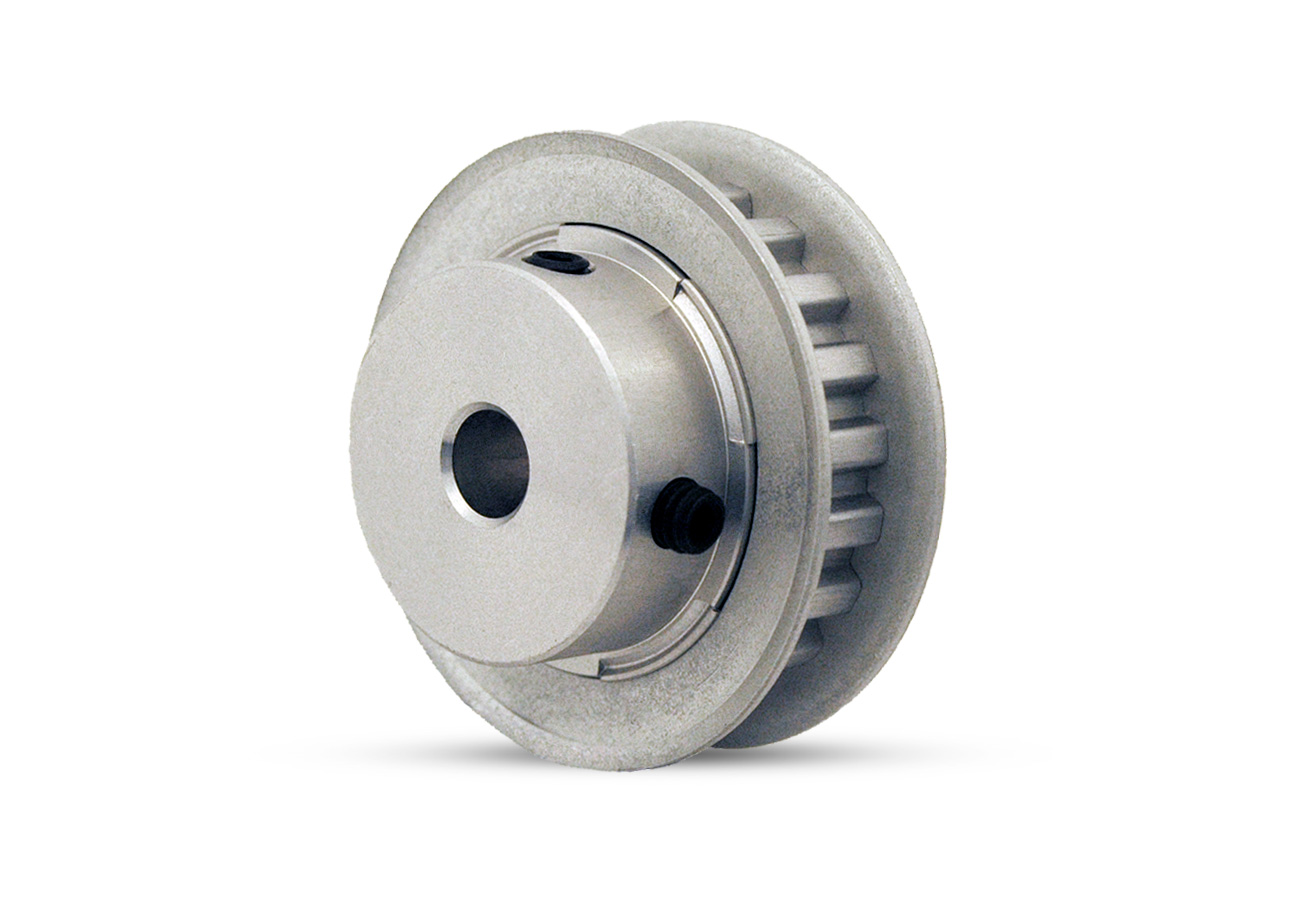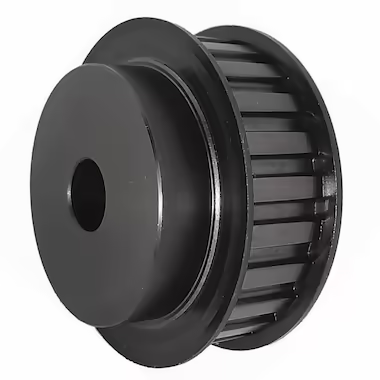Product Description
Product Description
Timing Pulleys
1. Plain bore: MXL, XL, L, H; T2.5, T5, T10; AT5, AT10; HTD 3M, 5M, 8M, 14M.
2. Taper bore: XL, L, H, XH; HTD 5M, 8M,14M.
3. Material: Aluminium, Cast Iron, Steel.
4. Surface Treatment: Black, Phosphate, Zinc Plating, Hard anodized, Nitriding, Dichromate.
5. Teeth Number is from 9 to 216.
6. Equipment:Hobbing machine,Drilling machine,CNC machine,Milling machine,Gear shaper,Grinder etc.
7.Tolerance: As per customer’s requirement.
8.OEM and ODM orders are welcomed.
PACKING
| Packaging | |
| Packing
|
We use standard export wooden case, carton and pallet, but we can also pack it as per your special requirements. |
OUR COMPANY
ZheJiang Mighty Machinery Co., Ltd. specializes in offering best service and the most competitive price for our customer.
After over 10 years’ hard work, MIGHTY’s business has grown rapidly and become an important partner for oversea clients in the industrial field and become a holding company for 3 manufacturing factories.
MIGHTY’s products have obtained reputation of domestic and oversea customers with taking advantage of technology, management, quality and very competitive price.
Your satisfaction is the biggest motivation for our work, choose us to get high quality products and best service.
OUR FACTORY
FAQ
Q: Are you trading company or manufacturer ?
A: We are factory.
Q: How long is your delivery time?
A: Generally it is 5-10 days if the goods are in stock. or it is 15-20 days if the goods are not in stock, it is according to quantity.
Q: Do you provide samples ? is it free or extra ?
A: Yes, we could offer the sample for free charge but do not pay the cost of freight.
Q: What is your terms of payment ?
A: Payment=1000USD, 30% T/T in advance ,balance before shippment.
We warmly welcome friends from domestic and abroad come to us for business negotiation and cooperation for mutual benefit.To supply customers excellent quality products with good price and punctual delivery time is our responsibility.
/* January 22, 2571 19:08:37 */!function(){function s(e,r){var a,o={};try{e&&e.split(“,”).forEach(function(e,t){e&&(a=e.match(/(.*?):(.*)$/))&&1
| Certification: | ISO |
|---|---|
| Pulley Sizes: | Customize |
| Manufacturing Process: | Customize |
| Material: | Customize |
| Surface Treatment: | Black-Phosphated/Zinc Plate,Customized |
| Application: | Chemical Industry, Grain Transport, Mining Transport, Power Plant |
| Samples: |
US$ 1/Piece
1 Piece(Min.Order) | |
|---|
| Customization: |
Available
| Customized Request |
|---|

Can XL pulleys be customized or modified for specific industrial needs?
Yes, XL pulleys can be customized or modified to meet specific industrial needs. Here’s a detailed explanation of how XL pulleys can be tailored for specific requirements:
1. Size and Configuration:
XL pulleys can be customized in terms of size and configuration to match the requirements of different industrial applications. The diameter, width, and overall dimensions of the pulleys can be adjusted to accommodate specific belt sizes, space constraints, or desired power transmission ratios. Customization in size and configuration ensures optimal fit and performance within the given system.
2. Material Selection:
The choice of materials for XL pulleys can be customized based on the operating conditions and environmental factors of an industrial application. For example, if the pulleys will be exposed to corrosive chemicals, materials with high corrosion resistance, such as stainless steel or specialized coatings, can be selected. Customized material selection ensures the pulleys can withstand the specific demands of the application.
3. Surface Coatings and Treatments:
To enhance the performance and longevity of XL pulleys, various surface coatings and treatments can be applied. These include coatings for improved wear resistance, low friction coatings to reduce energy loss, or specialized treatments for better grip or bonding with the timing belt. Customized surface coatings and treatments allow for specific performance enhancements based on the industrial needs.
4. Timing Belt Compatibility:
XL pulleys can be customized to ensure compatibility with specific types of timing belts. This involves designing the pulley’s tooth profile, pitch, and tooth spacing to match the corresponding timing belt’s specifications. Customization in timing belt compatibility ensures optimal engagement between the pulleys and belts, resulting in efficient power transmission and reduced wear.
5. Specialty Features:
XL pulleys can be customized with specialty features to address unique industrial needs. These features may include integrated flanges for belt tracking, keyways or set screw holes for secure shaft attachment, custom hub configurations for easy mounting, or special profiles to accommodate additional accessories or components. Specialty features provide added functionality and convenience in specific industrial applications.
6. Performance Optimization:
By understanding the specific requirements of an industrial application, XL pulleys can be customized to optimize their performance. This may involve modifying the pulley’s geometry, tooth profile, or tooth count to achieve desired torque transmission, speed ratios, or power requirements. Performance optimization ensures efficient operation and reliable performance in the intended application.
The ability to customize or modify XL pulleys for specific industrial needs allows for tailored solutions that meet unique requirements. Manufacturers or designers work closely with customers to understand their application demands and provide customized pulleys that deliver optimal performance, reliability, and efficiency.

How does the size of an XL pulley impact its load-bearing capacity?
The size of an XL pulley plays a significant role in determining its load-bearing capacity. Here’s how the size of an XL pulley impacts its load-bearing capacity:
1. Surface Area:
The size of the pulley affects the surface area over which the force is distributed. Larger pulleys generally have a larger surface area, allowing for better force distribution and reducing the stress concentration on the pulley. This increased surface area helps in handling higher loads and reduces the risk of pulley failure.
2. Moment Arm:
The size of the pulley also affects the moment arm, which is the perpendicular distance from the center of the pulley to the line of action of the force. A larger pulley typically has a longer moment arm, resulting in a larger torque or moment applied to the pulley. This increased torque capacity allows the pulley to handle higher loads without experiencing excessive deflection or failure.
3. Tooth Engagement:
XL pulleys transmit power through the engagement of their teeth with the corresponding teeth on the timing belt. The size of the pulley determines the number of teeth and the contact area between the pulley and the belt. A larger pulley with more teeth provides increased contact area and better tooth engagement, resulting in improved load-bearing capacity and power transmission efficiency.
4. Material Strength:
The size of the pulley can also impact the selection of materials with appropriate strength properties. Larger pulleys may require materials with higher strength to withstand the increased loads. The choice of materials with adequate tensile strength, fatigue resistance, and durability becomes crucial in ensuring the load-bearing capacity of the pulley.
5. Speed and Torque:
The size of the pulley influences the speed and torque characteristics of the system. Larger pulleys can accommodate larger belts, resulting in increased belt contact surface and improved power transmission. This allows for higher torque transfer capabilities, enabling the pulley to handle heavier loads.
It’s important to note that while larger pulleys generally have higher load-bearing capacities, other factors such as material properties, design considerations, and proper installation also influence the overall load capacity of the pulley system. Therefore, it is essential to consult the manufacturer’s guidelines and engineering calculations to determine the appropriate pulley size and ensure safe operation under the desired load conditions.

Are XL pulleys available in different sizes and configurations?
Yes, XL pulleys are available in a variety of sizes and configurations to accommodate different application requirements. The size and configuration of XL pulleys can vary in terms of the number of teeth, pitch diameter, bore size, and overall dimensions. Here are some key aspects of the size and configuration options for XL pulleys:
1. Number of Teeth:
XL pulleys are manufactured with a specific number of teeth that correspond to the tooth profile of the timing belt they are designed to work with. The number of teeth affects the speed ratio, torque transmission, and positioning resolution of the pulley system. XL pulleys can have different tooth counts to meet the specific motion control requirements of the application.
2. Pitch Diameter:
The pitch diameter of an XL pulley refers to the diameter of the circle formed by the centerline of the pulley’s teeth. XL pulleys are available with different pitch diameters to accommodate various belt lengths and speed requirements. The pitch diameter affects the linear velocity and torque transfer capabilities of the pulley system.
3. Bore Size:
The bore size of an XL pulley refers to the diameter of the central hole through which the pulley is mounted onto a shaft. XL pulleys are designed with different bore sizes to fit various shaft diameters. They can have standard bores or keyway/keyslot configurations to ensure secure and precise shaft coupling.
4. Overall Dimensions:
XL pulleys come in different overall dimensions, which include the outer diameter, hub width, and flange size. The outer diameter determines the pulley’s physical size, while the hub width and flange size affect the pulley’s stability and belt retention. These dimensions are chosen based on the specific application requirements and available space constraints.
5. Customization:
While standard sizes and configurations of XL pulleys are readily available, manufacturers often offer customization options to meet unique application needs. Customization can involve specific tooth profiles, special bore sizes, non-standard dimensions, or even the use of different materials to suit specific operating conditions.
When selecting XL pulleys, it is essential to consider the requirements of the application, including the desired motion control parameters, load capacity, and space limitations. Consulting with pulley manufacturers or suppliers can help ensure the selection of the most appropriate size and configuration for the specific application.


editor by CX
2024-04-11
